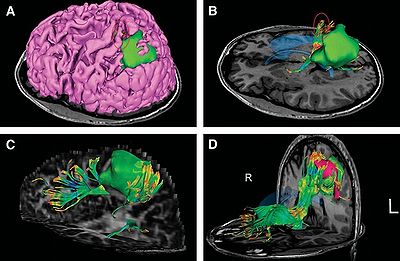Events: DTI Tractography Challenge MICCAI 2011
Contents
DTI Tractography for Neurosurgical Planning: A Grand Challenge
Note: this page is under construction
Outline: Diffusion Tensor Imaging (DTI) tractography has a unique potential for neurosurgical planning since it provides a window on the complex organization of white matter pathways in-vivo. During the past decade, the MICCAI community has been a major contributor to the development and refinement of a wide variety of advanced tractography techniques. This workshop will give participants the opportunity to evaluate the performances of their tractography algorithms in a neurosurgical context. Participants will gain insights on the currently available gold-standard for evaluating tractography results in the Operating Room, in the absence of ground truth.
Faculty
- Sonia Pujol, Ph.D., Surgical Planning Laboratory, Brigham and Women’s Hospital, Harvard Medical School
- Ron Kikinis, M.D., Surgical Planning Laboratory, Brigham and Women’s Hospital, Harvard Medical School
- Alexandra Golby, M.D., Department of Neurosurgery, Brigham and Women’s Hospital, Harvard Medical School
- Guido Gerig, Ph.D.,The Scientific Computing and Imaging Institute, University of Utah
- Martin Styner, Ph.D., Neuro Image Research and Analysis Laboratory, University of North Carolina
- William Wells, Ph.D., Surgical Planning Laboratory, Brigham and Women’s Hospital, Harvard Medical School
- Carl-Fredrik Westin, Ph.D., Laboratory of Mathematics in Imaging, Brigham and Women’s Hospital, Harvard Medical School
Workshop Format
The workshop will be composed of two parts: the first part will consist of a series of presentations of the tractography algorithms and results by the workshop participants, in parallel with the grand challenge contest; the second part will focus on the results of the contest, and discussions on tractography challenges and clinical use of DTI for neurosurgical planning.
Logistics
The DTI Tractography Challenge workshop will be held on Sunday September 18, 2011 at the Westin Harbour Castle, 1 Harbour Square, Toronto, Canada. To register for the workshop, please visit the MICCAI 2011 conference website. For questions related to this event, please send an e-mail to Sonia Pujol (spujol at bwh.harvard.edu).
Submission
- Participants will be required to submit their tractography results and a short paper describing their analysis. The paper should include the following elements 1) a presentation of the DTI analysis pipeline, 2) a description of the tractography technique and parameters used, 3) a set of images providing an intuitive way to present the reconstructed tracts to neurosurgeons. Supplementary materials such as short videos, are encouraged, but not mandatory.
- Participants will be invited to propose an evaluation criteria for their tractography method.
- Segmentation of the tract of interest should be performed in both hemispheres
- Tractography results should include the enveloppe of the reconstructed tracts
- Results should be submitted in the ITK-readable NRRD file format.
Dead-line for submission: June 1st, 2011.
Evaluation
The correct depiction of the tract displacement, lesion infiltration, as well as false-positive tracts and false-negative findings will be assessed by three experts neurosurgeons. The reliability of the tractography algorithms will be evaluated using bundle overlap and fiber profiles of diffusion properties on the test/retest data.
Datasets
The workshop datasets will consist of four neurosurgical cases acquired at Brigham and Women's Hospital, and two healthy subjects. Each dataset will include Anatomical Images (T1,T2 and FLAIR), a Diffusion Weighted Imaging (DWI) volume, and a Diffusion Tensor Imaging (DTI) volume. Data will be in the ITK-readable Nrrd file format, which consists of an ASCII header file and a separate uncompressed raw image datafile.

